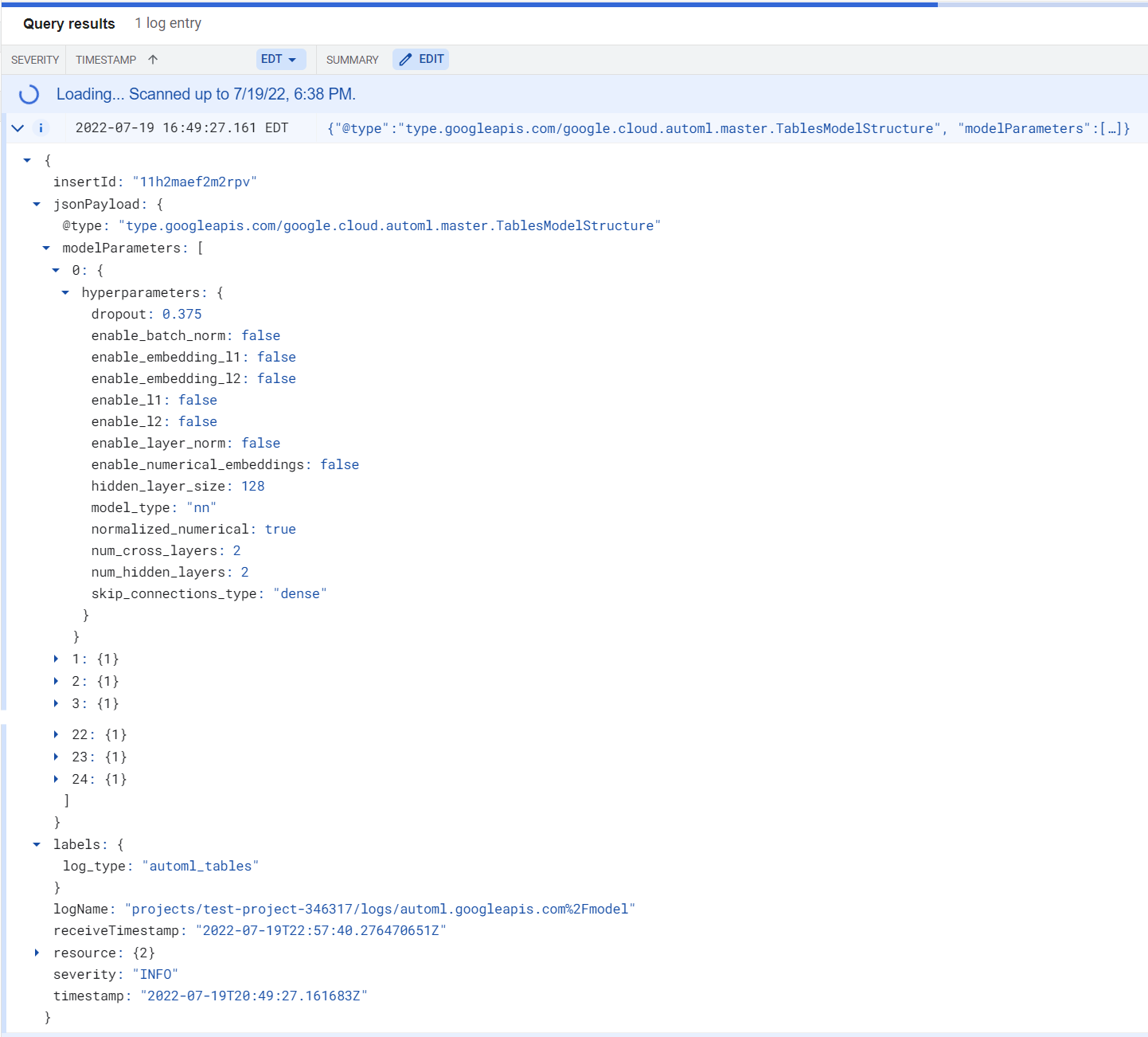This page provides information about how to use Cloud Logging to view details about a Vertex AI model. Using Logging, you see:
- The hyperparameters of the final model as key-value pairs.
- The hyperparameters and object values used during model training and tuning, as well as an objective value.
By default, logs are deleted after 30 days.
The following topics are covered:
Before you begin
Before you can view the hyperparameter logs for your model, you must train it.
To perform this task, you must have the following permissions:
logging.logServiceIndexes.liston the projectlogging.logServices.liston the project
Viewing training logs
You can use the Google Cloud console to access the hyperparameter logs of the final model and the hyperparameter logs of the tuning trials.
In the Google Cloud console, go to the Vertex AI Models page.
In the Region drop-down, select the region where your model is located.
From the list of models, select your model.
Select your model's version number.
Open the Version Details tab.
To see the hyperparameter log of the final model, go to the Model hyperparameters row and click Model.
There is just one log entry. Expand the payload as shown below. For details, see Log fields.

To see the hyperparameter log of the tuning trials, go to the Model hyperparameters row and click Trials.
There is one entry for each of the tuning trials. Expand the payload as shown below. For details, see Log fields.

Log fields
Activity logs are structured as described in the LogEntry type documentation.
Vertex AI model logs have, among other fields:
labels: Thelog_typefield is set toautoml_tables.jsonPayload: The specific details of the log entry, provided in JSON object format. For details, see Payload contents for the hyperparameter log of the final model or Payload contents for the hyperparameter log of a tuning trial.timestamp: The date and time when the model was created or the trial was run.
Payload contents for the hyperparameter log of the final model
The jsonPayload field for the hyperparameter log of the final model contains a
modelParameters field. This field contains one entry for each model that
contributes to the final ensemble model. Each entry has a hyperparameters
field, whose contents depend on the model type. For details, see List of hyperparameters.
Payload contents for the hyperparameter log of a tuning trial
The jsonPayload field for the hyperparameter log of a tuning trial contains the following fields:
| Field | Type | Description |
|---|---|---|
modelStructure |
JSON |
A description of the Vertex AI model structure.
This field contains a |
trainingObjectivePoint |
JSON | The optimization objective used for model training. This entry includes a timestamp and an objective value at the time the log entry was recorded. |
List of hyperparameters
The hyperparameter data provided in the logs differ for each type of model. The following sections describe the hyperparameters for each model type.
Gradient boosted decision tree models
- Tree L1 regularization
- Tree L2 regularization
- Max tree depth
- Model type:
GBDT - Number of trees
- Tree complexity
Feedforward neural network models
- Dropout rate
- Enable batchNorm (
TrueorFalse) - Enable embedding L1 (
TrueorFalse) - Enable embedding L2 (
TrueorFalse) - Enable L1 (
TrueorFalse) - Enable L2 (
TrueorFalse) - Enable layerNorm (
TrueorFalse) - Enable numerical embedding (
TrueorFalse) - Hidden layer size
- Model type:
nn - Normalize numerical column (
TrueorFalse) - Number of cross layers
- Number of hidden layers
- Skip connections type (
dense,disable,concat, orslice_or_padding)
What's next
Once you're ready to make predictions with your classification or regression model, you have two options:
- Make online (real-time) predictions using your model.
- Get batch predictions directly from your model.
Additionally, you can:
- Evaluate your model.
- Review general information about Cloud Logging.
- You can export your logs to BigQuery, Cloud Storage, or Pub/Sub. Read Route logs to supported destinations in the Logging documentation to learn how to export activity logs.
